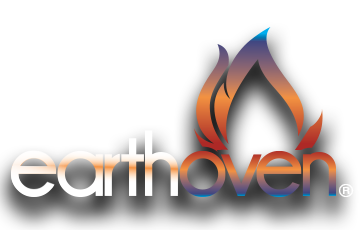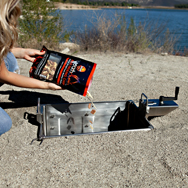Starting Your Fire
Starting a wood fire differs from starting charcoal. I like to avoid starting my fire with any chemical fire starters. The residue they leave behind isn’t something I want to cook over! I like to think that starting your Earth Oven is like starting a fire in your fireplace. This was something I looked forward to as a kid growing up, so I’d like for my kids to have that same experience, now with the Earth Oven! Gathering a couple handfuls of natural kindling (e.g., twigs, sticks, dry leaves) or even a few pieces of charcoal can help get the fire going. If you place your logs in a “Teepee” formation it helps the air circulate for an even burn. You may even stuff the “Teepee” with some organic cardboard and/or paper. After the Earth Oven is fired up, and the logs have had sufficient time burning, you may carefully knock the logs down to a horizontal position, and you can add additional wood if necessary. I like to get a nice big fire going, but the more wood you put into your Earth Oven, the longer time it takes for it to burn down for the best cooking/smoking coals! For those of us not in a hurry, that’s just fine!
Grilling on Embers, Not An Open Flame
Experience has taught me the mistake of inserting food into the Earth Oven to soon. Whether grilling on the grill racks or searing on the griddle, remember to be patient for the coals and embers to be formed. Look for glowing red embers, where your wood looks like it has turned to carbon, or like it is falling apart into the bottom. Those dancing, glowing, red embers are actually hotter than the flames you see in the previous state of the burn process. It’s important to wait because, if the wood is still “burning,” it may start a fire inside of your Earth Oven, and char your food. A thoroughly “broken down” ember is best for a clean cook, so as to enhance the process of “caramelization” of your foods. Many fine restaurants use oak for their initial burn, because it tends to never “over power” prepared foods. And, Oak is usually easy to find.
Indirect Heat
Occasionally, even though you have burned your wood down to embers you may still experience “flare up’s.” One method to reduce “flare up’s” is to move your embers or coals over to one side of your Earth Oven, placing your foods on the opposite side of the grill. Such “Indirect Heat” enables you to use the radiant convection of heated air and smoke to cook your food rather than direct flames. This is particularly important, because fatty, juicy liquids from your foods tend to drip to the bottom, causing “flare ups” inside the oven that can ruin your meal! The method of using indirect heat will greatly reduce “flare up’s”, and it will help to keep your foods from charring on the “outside” before the “inside” gets properly cooked. This method also allows for continual stoking of the fire while keeping food away from the flames. This works well for longer cooking/smoking larger cuts of meat like roasts and briskets.
Another great benefit of an Earth Oven cook, is that you may still enjoy the warmth and ambience of your Earth Oven experience, because the Earth Oven can produce heat long after the cooking is finished. Time for some “s’mores” for dessert? Need added warmth, or want to see more flames flicker while your satisfying meal settles? Simply throw on another log and your Earth Oven should fire right back up!
Thank you for reading. We hope that these pointers will be helpful and enhance your cooking experience.
Should you have any suggestions or questions about your Earth Oven cooking experiences, please let us know so that we can share them with others.
‘Til The Next Time,
Rick
Earth Oven. The Newest Most Ancient Way To Cook!Rick Steinke

